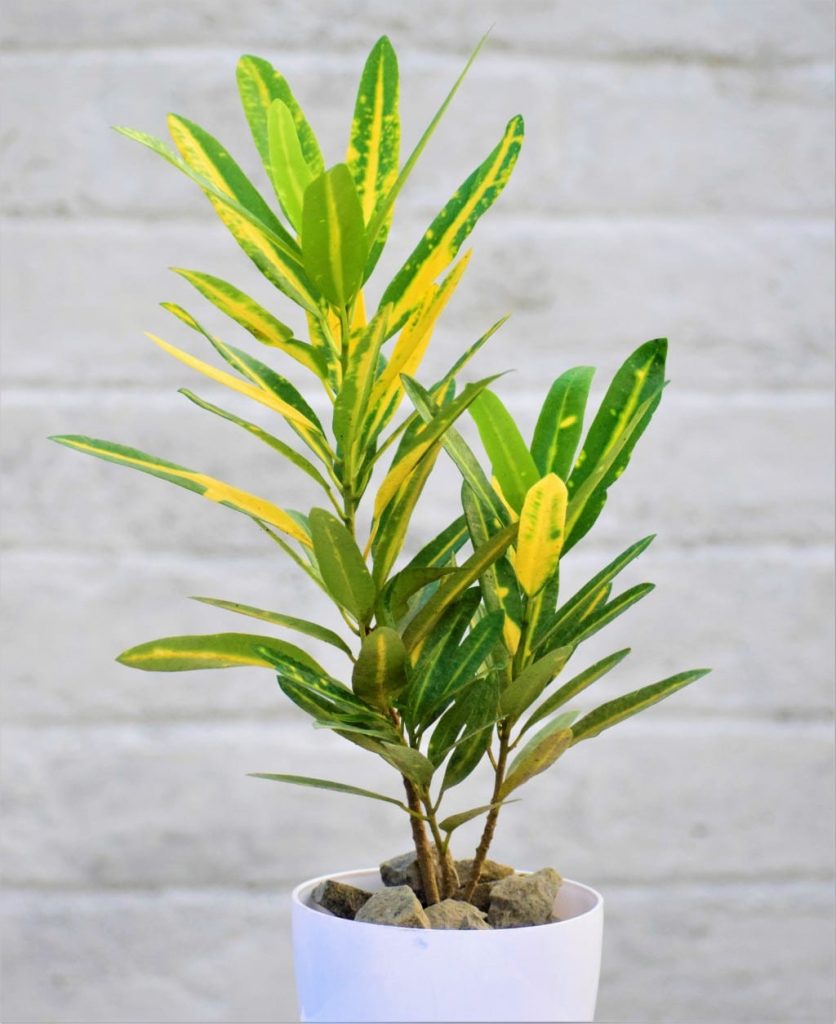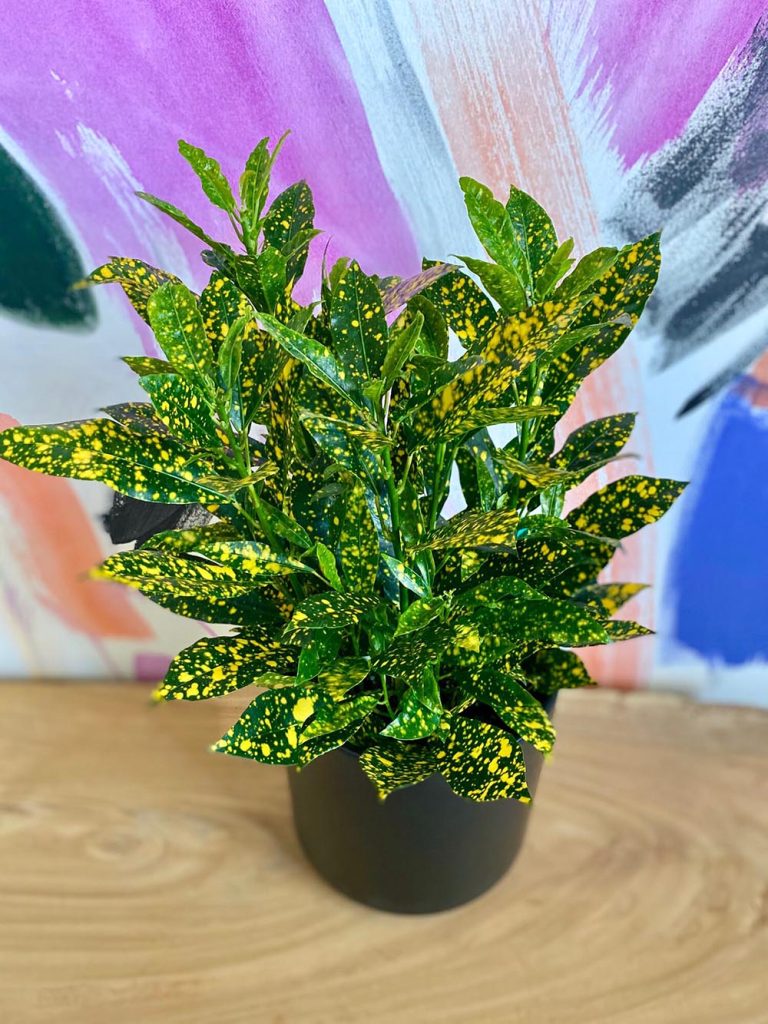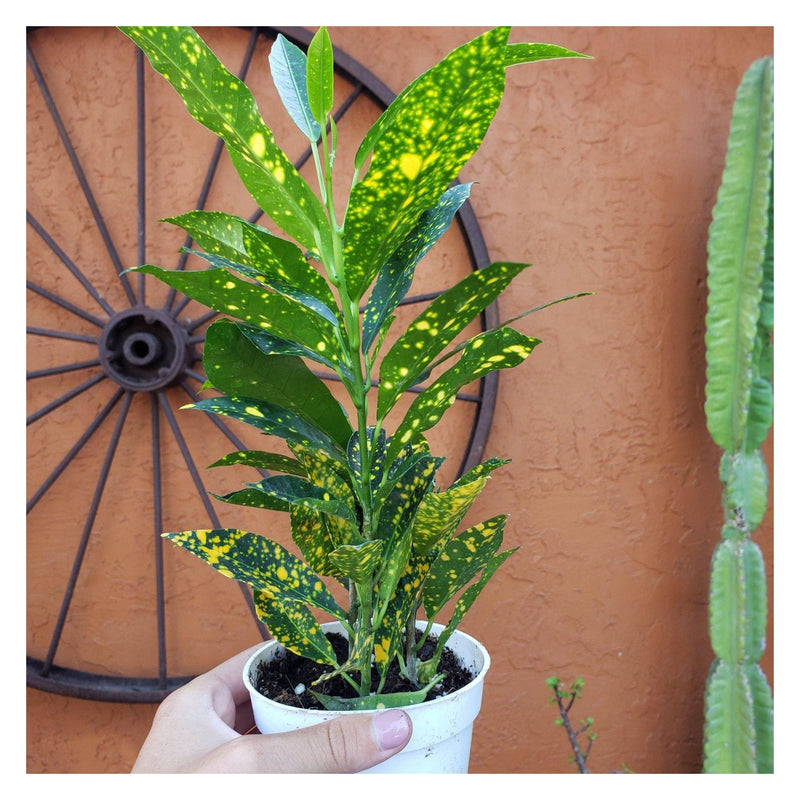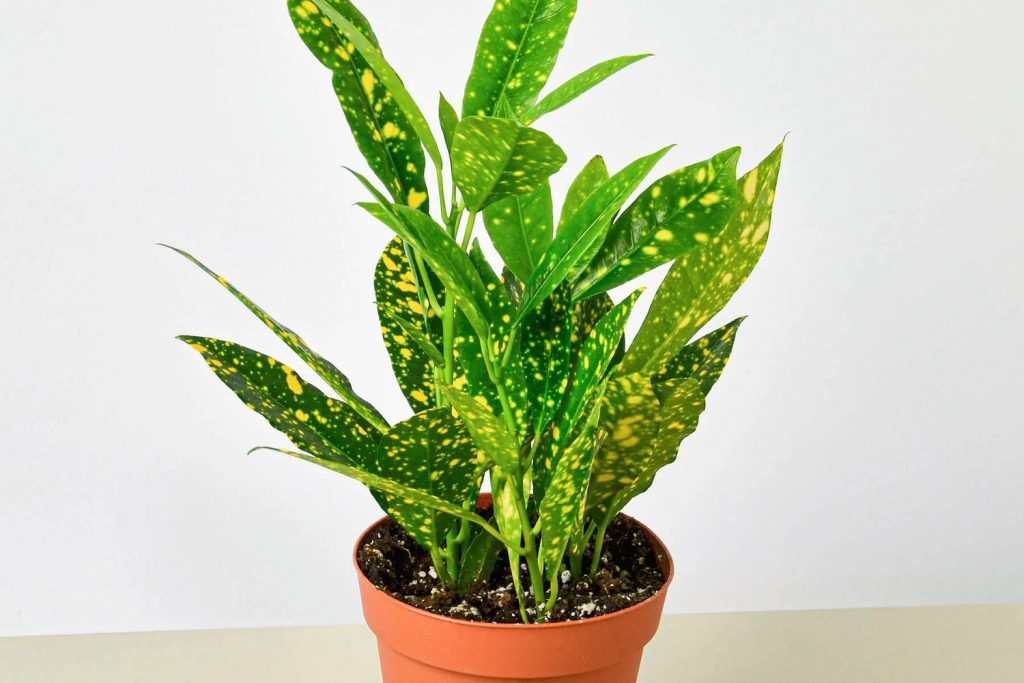Croton plants are one of the most beautiful to grow, either indoor or outdoor plants. The combination of colors in the homes, gives a feel of the tropical regions, while also beautifying the home. A favorite among the croton variety is the gold dust croton.
Contrary to other croton varieties, this plant comes with just two colors, however, these colors are beautifully combined such that they dazzle wherever they are placed.
This uniqueness earned it the name gold dust. Understanding each variety of a plant is important, although often time, a lot of people assume these plants have the same care guide and this is not usually so.
Come through with us as we give you all the information you need to grow and care for your gold dust croton.
Gold Dust Croton Explained
Also known as Codiaeum variegatum ‘gold dust’, the gold dust variety of croton is popularly known as a perennial shrub that is classified as a subtropical plant; this is because gold dust croton is native to the eastern pacific island, Indonesia, and southern Asia.
The plant’s glamorous foliage makes it stand out among the other members of the croton family and other plants.
The plant is characterized by its green leaves with yellow to golden spots all around it. In its natural habitat, the gold dust croton is known to grow to about 10 feet tall, however, the cultivated ones as houseplants are found to only grow to about 2 feet tall.

| Common name | Gold Dust Croton |
| Scientific name | Codiaeum variegatum ‘gold dust’ |
| Plant type | Perennial shrub |
| Soil type | Well-draining soil |
| Light | Bright, indirect light. |
| Plant pH | Slightly acidic, 6 to 7.5 pH |
| Native | Eastern Pacific, Indonesia, and Southern Asia |
| Toxicity | Toxic |
Gold Dust Croton Propagation
The best way to propagate the gold dust croton is via stem cutting. Stem cutting involves cutting a part of your living gold dust plant and growing it. As simple as that!
Needs for propagation:
- A healthy gold gust croton
- Sterilized sharp knife or gardening shears
- Well-draining soil.
Steps To Propagate Gold Dust Croton
Below are steps to accomplish your quest of getting new gold dust croton babies, following these steps should land you one or more young gold dust croton to grow.
Step 1: Make a cutting of about 4 to 6 inches from a healthy and mature gold dust croton plant. Ensure to make use of a sterilized knife or shears.
Step 2: Remove the leaves below on the stem and leave 3 to 4 leaves on the top. Dip the bottom of the stem into a rooting hormone; this is fasting up the rooting process. However, if you do not have a rooting hormone, you can grow your cutting without it.
Step 3: Prepare your pot and soil, ensure the soil is well-draining, preferably make use of peat moss and perlite, these will help with proper draining while also keeping your soil moist. Cover up the plant with a plastic bag for a while; this is to ensure that the plant stays moist as it would in a greenhouse.
Step 4: In about 4 weeks, your plant should develop its roots. Remove the plastic bag and care for it with the care required of a normal gold dust croton.
Gold Dust Croton Care Guide
This care guide includes all of the dos and don’ts of the gold dust croton. Strict adherence to this guide will produce a healthy and flourishing gold dust croton plant.
1. Light
Lighting is very important to all croton plants, and the gold dust croton is not different most croton plants do best in bright direct light, however, the gold dust croton is different.
The plant requires about 4 to 6 hours of bright, indirect sunlight. Exposing your gold dust croton to too much sunlight can burn the plant and make it look ugly, the same way less light will hinder its beauty as well as growth.
The right type of light your gold dust croton needs to have better foliages with popping colors is bright, indirect light. The brighter the light, the better the foliage.

2. Soil
Gold dust croton thrives best in rich, well-draining soil. We recommend that this plant is grown in slightly acidic soil, with 5.0 to 7.5 pH. An important aspect of the soil type for gold dust croton is soil that drains water properly while also keeping the plant moist. Remember that this variety of croton is a subtropical plant, and they will not tolerate sitting in waterlogged soil.
Ensure that your soil is filled with properties that will enhance its drainage system. For utmost care, we recommend that you mix these materials with the help of an expert or purchase already mixed soil at your local nursery.
3. Humidity:
We recommend that you keep your croton shrubs at a humidity level of 40% to 60%, these plants are native to tropical areas, and hence humidity is an important part of their development. There are several ways to increase humidity for your plant; misting them as often as possible is an effective way of increasing humidity.
Placing your gold dust croton on a pebble tray does it too. If all of these are not providing as much humidity as it would require, you can purchase a plant humidifier for more effort.
4. Temperature
Your gold dust croton should be placed in temperatures that are above 50 degrees F alone, anything below that is term as dangerous for your plant and can kill them. Bearing in mind that the gold dust croton is a subtropical plant, it is advisable to keep your plant at 60 to 85 degrees F. do not forget to keep them away from hot or cold drafts.
5. Water
Watering the gold dust croton can be a little tricky, however, you only need to master it for a while, and you are good to go! The gold dust croton like other types of croton will not tolerate overwatering as well as under-watering, how then do you strike a balance? Our hack is that you should only water your plant when the topsoil is completely dried.
Water the plant slowly, yet thoroughly. The plant needs to stay moderately watered yet moist. When watering, allow the soil to soak in the water and watch as it goes to the root, if there is excess water from the drainage holes, ensure you monitor and see that the water is discarded.
Leaving your plant to sin in water is as good as overwatering it and this only calls for diseases. Good thing? Your plants will let you know if it is being overwatered or underwatered, you should pay attention to your plant to know when there is a sign.
6. Fertilizer
The recommended time to feed your plant is during the growing seasons.
Gold dust croton, when provided with the best soil alongside organic matters may not require feeding for a long time; however, we advise that they be provided soluble fertilizers during their growing seasons. We also recommend that you follow the instruction on the pack of the fertilizers you are using or consult an expert.
Growing Tips
- Gold dust croton will require repotting as they grow. the best time to repot is in spring and this should be done once a year. You must purchase a larger size of the pot than the present one when planning to re-pot.
- The best type of pot for your gold dust croton is one with at least one drainage hole.

- Pruning is a time to get rid of dead or damaged leaves from the healthy ones. It also helps you keep your croton in shape. Ensure you do not cut off too many leaves as this can send the plant into shock.
- Root rot is a serious disease for gold dust croton and is only gotten from overwatering. To protect your plant from getting infected, good drainage holed pot and well-draining soil.
- Spider mites, mealybugs, and scale insects are common pests your gold dust croton might face, however, they can be removed with the use of essential oils; neem oil, insecticidal soap, or rubbing alcohol.
Gold Dust Croton Plant Parent FAQs
Here are some of your burning questions about this plant answered.
Is The Gold Dust Croton Plant Toxic?
Yes, like the rest of its family, gold dust croton is considered toxic to both humans and animals. Intake and contact with gold dust croton’s sap can result in itching, irritation in the mouth as well digestive problems
Why Is My Gold Dust Plant Wilting?
Although wilting for other plants can be a sign of many other things, however for gold dust croton, wilting is a sign of overwatering. if your plant is wilting, ensure to give it time to properly dry out before watering, also, do not water too much.
My gold dust croton does not have golden spots, why?
The absence of yellow to golden spots on your gold dust croton plant signifies that your plant is not receiving as much light as it requires. Plants with multiple colors require enough light, to keep their colors and stay vibrant. If this is noticed, move your plant from where it is to where it can get about 4 to 6 hours of bright, indirect light daily.
How Long Can My Gold Dust Croton Live?
The gold dust croton plant is a perennial shrub and this means that they can live for a very long time, provided they are given the best care. A tested and trusted way of keeping your plant alive for a very long time is via propagation.
Final Thoughts
Gold dust croton is one of the most beautiful plants in the croton family; it wouldn’t hurt to put an extra effort into caring for your favorite and keeping it alive for a long time.
Growing gold dust croton in the home gives it a glamorous look and feel. Ensure to follow the care guide strictly, to land yourself a healthy plant.
Gold dust croton is a slow-growing plant, hence, enjoy the ride and be attentive to your plant.
More croton plant guides:

